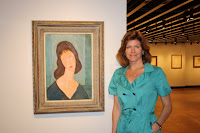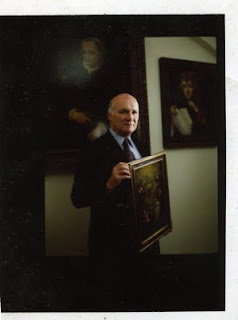Art Theft and the Case of the Stolen Turners
Sandy Nairne
Reaktion Press/ University of Chicago 2011
An Interview by Catherine Schofield Sezgin, ARCA Blog Editor-in-chief
An exceptional book on art theft has been published by a museum director who has received permission from his art institution to openly discuss the eight year quest to obtain the return of two stolen paintings. Sandy Nairne, now director of the National Portrait Gallery, has written "Art Theft and the Case of the Stolen Turners" and risked considerable criticism for his transparency. The ARCA blog will spend this week on a series of posts discussing the book in-depth.
In 1994, London's Tate Gallery loaned two paintings by J. M. W. Turner to a Frankfurt public gallery, the Schirn Kunsthalle to be included in an exhibition on "Goethe and the Visual Arts". The 1843 paintings, "Shade and Darkness - The Evening of the Deluge" and "Light and Colour (Goethe's Theory) - The Morning after the Deluge - Moses Writing the Book of Genesis", had been stolen on July 29 with a third painting, Caspar David Friedrich's "Waft of Mist" (1819, on loan from the Hamburg Kunsthalle).
 |
| Turner's "Shade and Darkness" |
Mr. Nairne, the Tate's director of programs and a trusted associate of Nicholas Serota, the Director of the Tate, oversaw the expenditure of almost 3.5 million pounds to recover the insured paintings. Martin Bailey of The Art Newspaper provided an excellent synopsis of the events in his online article dated August 9, 2011 ("My life as an undercover negotiator").
 |
| Turner's "Light and Colour" |
ARCA Blog: You have publicly discussed how the Tate negotiated the return of the two Turner paintings even though it has generated criticism about whether or not museums are encouraging art theft by paying money to recovery stolen art. The irony here, of course, according to Martin Bailey in The Art Newspaper, is that it was also a savvy financial deal -- the Tate received the insurance proceeds from the stolen paintings, repurchased the paintings from the insurance company at a lower amount, reinvested the money, and then recovered the paintings values of which have dramatically increased. The museum is more transparent than most about talking about art theft and you may be the first senior museum official to write about the long negotiations involved in recovering paintings. How did you come to break so many taboos? What would you say motivated you and the Tate to go to such lengths? What was it about these paintings that made them so important to the Tate's collection?
Sandy Nairne: These two paintings are part of what is known as the Turner Bequest, and had been selected by the artist as ones that should be specially valued by the nation. It felt like a clear duty for us at the Tate to do everything we could – as long as it was legal and approved by the right authorities – to get them back.
The insurance payments worked out successfully after the paintings had been recovered, but that might not have happened. It is only possible, of course, with hindsight to see it as a success.
In writing the book, I was not thinking of ‘breaking taboos’ but simply trying to set out the facts. The narrative from my perspective needed to set right quite a few things that had been mis-recorded in the newspapers in Britain. It became an additional matter to then analyse the wider questions around high value art theft.
ARCA Blog: Three thieves had remained in the gallery after closing time (this kind of theft is known as a 'stay-behind'); attacked and "held the guard, tied up, in a cleaning cupboard"; then used the guard's keys to unlock the back door and take the paintings (then worth 24 million Sterling pounds) out through the loading dock. You write:
This might have been fairly straightforward, but crucially, it was possible only with knowledge of the security system and the internal layout to execute the operation swiftly. While removing the paintings, the three men (two thieves and the waiting driver as it later emerged) would have been listening to the guard's radio, connected to Eufinger's headquarters [private security firm].
An alert was received at the security office 41 minutes after the city museum's front doors were locked. When you arrived in Frankfurt within hours of the theft, how puzzled were you and the rest of the security staff that only three paintings had been taken? Did you wonder why these three particular paintings had been chosen? And from the very beginning did you suspect that the paintings had been taken because the thieves knew they had been insured for the exhibit and that they had a possibility of receiving a ransom for the paintings return?
The Frankfurt police officer initially assigned to the case, Herr Bernd Paul, was a specialist in blackmail and ransom work and immediately began making inquiries in the "Frankfurt underworld" to find out who planned this. Herr Paul began his investigation with the idea that the pictures had been taken "hostage." Do you think this outlook from the beginning set up for a successful recovery of the art? At the same time, you were very concerned that everyone should understand that the paintings were irreplaceable and that not enough resources could be applied.
Sandy Nairne: I think the thieves may have been interrupted and that they had intended to take more than the three paintings. There was a very valuable Raphael painting nearby, though it was large and very heavy, while these three were relatively portable. I am not certain that these three were ‘targeted’ although later I did hear some talk of the police having recovered a list of works from one of the suspect thieves.
I had no idea initially why the Turners had been stolen. It seemed that it could have been a political matter or a protest of some kind, as much as an act organised by gangsters of some kind. It was only later when I learned much more about art theft that I began to understand how dominant is the financial motive.
Herr Paul’s reaction was logical, but there was never any ransom note from the thieves or those who had organised the theft. There was never any ghastly ‘pay or the paintings burn’ type of threat. Mostly it was other people trying to cash in on the theft. Criminality breeds criminality.
ARCA Blog: An image of one of the stolen paintings had been used to publicize the exhibition. This indicates that the thieves may have known nothing about the quality of the work and just took what they thought was important and valuable to the museum?
Sandy Nairne: This is possible – the poster may have been an additional point in the thieves mind as to which paintings they went for first.
ARCA Blog: You write that Mark Dalrymple, employed by the insurers to track the operation, is one of the most experienced of specialist loss adjusters in the insurance field. What do you think he did differently in handling this case that maybe someone with less training would have missed?
Sandy Nairne: Mark was always careful to remain very close to the police and ensure that they were informed appropriately, while also seeking independent information and contacts. There had to be trust on both sides. He is very experienced, and that experience counted a lot at the time, later on, when the Tate Trustees’ sub-committee was having to decide what was or was not appropriate by way of any ‘payment for information, leading to the recovery of the paintings’.
ARCA Blog: You alerted Scotland Yard's Art and Antiquities Squad three days after the theft when someone called the Tate looking for "someone in charge" about the stolen paintings. Detective Inspector Jill McTigue and then another senior officer, Dick Ellis, arrived with cameras and recording devices as they were being filmed for a documentary about the Art and Antiquities Squad for the BBC. You had two discussions with a man representing himself as the holder of the paintings which were now allegedly in London and would be 'auctioned' by the thieves unless he was paid 30,000 pounds for information leading to the pictures whereabouts. How nervous were you and how did you manage all of this commotion?
Sandy Nairne: I was very nervous, and it was confusing as I wanted this man ‘Rothstein’ to be real. But of course it emerged fairly soon that he was a confidence trickster only trying to make money by pretending that he had access to the stolen paintings. He was certainly very clever at spinning a yarn. I was relieved when he and his accomplice were both caught – but saddened that it took us no nearer to the actual paintings.
ARCA Blog: In addition, you were assigned an undercover plainclothes specialist to join you as your 'curator.' One of the first things done was to train him as how to pick up and examine a painting. At the beginning, you must have had hope that the paintings would be recovered shortly and not in eight years. Is your book in any way a cautionary tale for other museum staff? After all, you had a job and a family that needed your attention just as much as these paintings did.
Sandy Nairne: I hope it is not a cautionary tale, but encouraging to everyone that it is possible to get important works back into the public domain. I did not stop and analyse – in the sense of a broad view - what I was doing, as I was more concerned to make sure that I was doing it in the most effective way.
ARCA Blog: Your first contact was apprehended and arrested in a police operation that had pretended to pay a reward for the return of the paintings. The suspect and his accomplice did not have the paintings -- which the police had suspected - but a record in deception and petty crime. The entire first week of the investigation in London turned out to be a 'diversion'. However, a year later, on the anniversary of the suspect's arrest, you received a middle-of-the night phone call instructing you to meet in Moscow Square although this was not a part of any ongoing investigation. You cover all of this in the first 50 pages of your book. How did you manage to write your manuscript while working in a high-profile job?
Sandy Nairne: My writing was spread out over many years. I had kept notes and journals from when I was travelling to and from Frankfurt. It was only much later, in 2007, when I had a visiting Fellowship at the Clark Art Institute that I could really do most of the work to sort out the narrative and also do the reading on the existing literature relating to high value thefts of this kind. I have always done some writing very early in the morning, and used parts of weekends.
Additional posts will continue the discussion of "Art Theft and the Case of the Stolen Turners."
 Bernard Berenson,book reviews,Spring 2011,The Journal of Art Crime,Yearwood
Bernard Berenson,book reviews,Spring 2011,The Journal of Art Crime,Yearwood
 No comments
No comments
 Bernard Berenson,book reviews,Spring 2011,The Journal of Art Crime,Yearwood
Bernard Berenson,book reviews,Spring 2011,The Journal of Art Crime,Yearwood
 No comments
No comments































